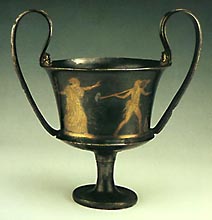There was a flowering in the output of metal vessels and utensils at Athens, particularly during the 5th century. Its importance often goes unrecognized, because at Athens, unlike other regions, objects of this sort were normally not used as grave-deposits. So we have very few specimens found on site. The normal item is a lebes of the sort used as a ash urn. Research in recent years has led to the conclusion that there were many other vessels of this kind made in Athens. These would have included types such as the drinking vessel (kantharos, kylix, and phiale), the oinochoe, and the hydria. In the latter half of the 5th century, there was a very popular group of hydriai decorated with busts of Sirens. The Athenian toreuts are also believed to have made use of decorative figures on hydria handles, in the 4th century, as clay moulds for figures of this kind have been found in the Agora. The moulds would have made mass-production of an item easier and quicker. |
 |





